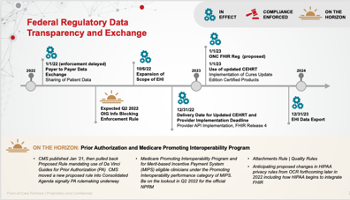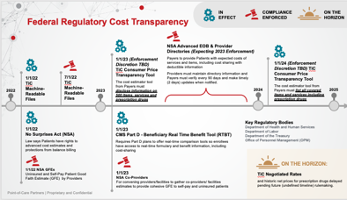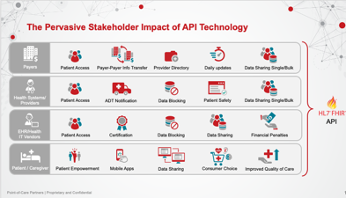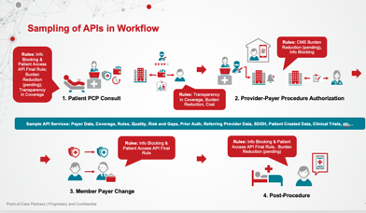 I sometimes imagine ways our journey to true interoperability could be expedited. I’m not espousing there is some magical pill that will solve all our woes in healthcare, but what if every stakeholder did just a little bit more than required to meet new rules and regulations? What if stakeholders broadened their perspective to imagine how they can reshape going beyond compliance into a competitive advantage? I think we’d all be amazed at how far and how quickly we could progress if everyone did just a little bit more than required.
I sometimes imagine ways our journey to true interoperability could be expedited. I’m not espousing there is some magical pill that will solve all our woes in healthcare, but what if every stakeholder did just a little bit more than required to meet new rules and regulations? What if stakeholders broadened their perspective to imagine how they can reshape going beyond compliance into a competitive advantage? I think we’d all be amazed at how far and how quickly we could progress if everyone did just a little bit more than required.
In a recent webinar, my colleague, Jocelyn Keegan, and I explored how the adoption of APIs (Application Programming Interfaces) is improving access to data and interoperability. We level set by giving an overview of the current regulatory landscape for data and cost transparency and reviewed the HL7 (HEALTH LEVEL 7) FHIR (Fast Healthcare Interoperability Resources) accelerator programs that are creating the standards for implementing real-time data exchange technologies. We acknowledge that there are early adopters already using APIs to reduce delays and burdens associated with data exchange in their internal workflows and with trusted external vendors and discussed their approaches, but I still wonder “What can be done to accelerate stakeholders who have fallen behind to travel the adoption curve more quickly?” First, let me share some of the information we covered during the webinar. And if you want to listen to the whole session, you can access it here.
Patient-Centered, Value-Based Health Care Demands Free Data
We all know there is a movement within the health care ecosystem where organizations of all sizes are evaluating their data platforms and data supply chains. Traditionally, the EHR/EMR have been the main source of data acquisition, and any new data technology adoption was driven by regulations and federal and state funding initiatives. Value-based health care and customer demand are changing the paradigm of who owns patient data, and HL7 FHIR-based applications are leveling the playing field for data exchange by providing accessible platforms regardless of an organization’s size. Quality, data-driven API options are now available to provide the right patient data at the right point in the workflow. EHR (Electronic Health Record) vendors are examining the Da Vinci Clinical Data Exchange (CDex) as well as developing their own proprietary solutions. Broader thinking health care organizations are evolving to ease access to data for trusted contractors prior to compliance enforcement. Imagine if this were more common.
Current Regulation Landscape
Here are some timelines and an overview of some of the regulatory and legislative activity including enforcement dates or delays.

Image 1 - Federal Regulatory Data Transparency and Exchange: Increased regulatory activity is aimed at improving data exchange and reducing burdens in 2022
The regulation timeline in image 1 shows the substantial changes taking place this year regarding data transparency. Currently, the industry is waiting for clarification on timelines for compliance enforcement and requirements. New information about the Information Blocking enforcement rule is expected in Q2 2022.

Image 2 - Federal Regulatory Cost Transparency: 2022-2023 Legislation and CMS policy changes provide real-time cost and benefit data to patients
Also taking effect in January of 2022, the No Surprises Act (NSA) ensures unprecedented cost transparency for health care patients. The law says patients have rights to advanced cost estimates and protection from balance billing, and uninsured or self-pay patients have the right to Good Faith Estimates (GFE) by providers. The portion of NSA that applies to co-providers and facilities will be enforced beginning January 2023.
Interoperability Is More Than an IT Initiative, It Is a Business Culture

Image 3 - The Pervasive Stakeholder Impact of API Technology: Early adopters of API-based data platforms are sharing proof point and success stories of organization-wide efficiencies
Successful health care organizations are thinking beyond the next regulation or compliance incentive. They are reaching out from within the existing silos of information to create new workflows. This level of change requires communication and collaboration throughout the entire organization, not just the IT or EHR support team. And the collaboration must extend beyond the four physical walls of your business to include other organizations involved in the continuum of care. As more organizations demonstrate how leveraging APIs can positively transform the patient/consumer experience, the organizations that haven’t dipped their toe in the water will be left behind as consumers begin to realize who will provide what they are asking for which is access to their data when they need it, more seamless interactions with providers and payers, and less redundant form filling.
Interoperability Conversation Starters

Image 4 - Sampling of APIs in Workflow: APIs oversee the capture and use of patient data throughout the patient journey
And this does not just benefit the patient; better data exchange benefits everyone. The above graphic breaks down what some of the more recent rules are trying to accomplish. Just imagine if an organization approached executing their interoperability roadmap in a comprehensive way, considering the business processes and possible organizational structure itself that might need to change. It could result in improved analytics, additional staff training to handle new data, and could uncover enhancements to how an organization can and should work with partners.
If your organization is considering taking a different approach that is above and beyond checking the regulatory box, I recommend asking the following:
- How could open data access improve your customer experience? Whether through product design, new services, or simply better customer service
- How can open data access and the new products and services allow you to differentiate yourself from your competition?
- Based on what your organization wants to accomplish over the next 5 or 10 years, how should you prioritize the adoption and utilization of APIs?
- How will you manage or drive change within your organization? How will you communicate this change externally?
I know adoption of new technologies can be daunting and choosing to approach radical business process transformation can be downright overwhelming, but I’d posit that the thought of being behind the eight ball when it comes to meeting a regulation or having your team put out fire after fire is worse. If you need help assessing or reevaluating your interoperability roadmap or in educating your broader staff to help them, get ready for a shift in how you do business, reach out to me at Teresa.younkin@pocp.com. I’d love to talk with you and discuss how we might be able to help.




